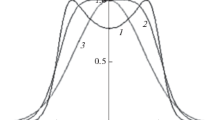Abstract
We derive an expression for the harmonic content of the oscillatory magnetization (de Haas-van Alphen effect) which is valid in the most general case, when the harmonic amplitudes and the relative harmonic phases of the pure Lifshitz-Kosevitch (LK) theory are modified by an arbitrary combination of magnetic interaction (MI), spin-scattering anisotropy (SSA) and exchange shift effects. The calculation produces several conclusions which bear directly upon the possibility of generally being able to determine separately the up-spin and down-spin conduction electron lifetimes in the presence of magnetic impurities, by means of measurements of the amplitudes and relative phase of the fundamental and second harmonic dHvA oscillations. We have shown that not only does SSA shift the first and second LK harmonics in phase, by amountsΔΘ1 andΔΘ2, but SSA also shifts the second harmonic magnetic interaction component by an amount 2ΔΘ1. We find that, in general, the combined effect of both MI and SSA on the observable relative phase angle, (2 Θ1−Θ2), can either add or cancel. In the limit in which the second harmonic is dominated by the MI component it can be shown that (2 Θ1−Θ2) goes to π, regardless of the amount of SSA, so that no useful information regarding SSA can be obtained from (2 Θ1−Θ2) in this case. Measurable quantities and measurement techniques, for the determination of SSA, are discussed briefly.
Similar content being viewed by others
References
Alles, H. G., Higgins, R. J., Lowndes, D. H.: Phys. Rev. Letters30, 705 (1973)
Alles, H. G., Higgins, R. J.: Phys. Rev.9 B, 158–173 (1974)
Coleridge, P. T., Scott, G. B., Templeton, I. M.: Canad. J. Phys.50, 1999 (1972)
Phillips, R. A., Gold, A. V.: Phys. Rev.128, 932 (1969)
Shoenberg, D.: Phil. Trans. Roy. Soc. (London)A255, 85 (1962)
Shiba, Hiroyuki: Progr. Theor. Phys.50, 1797–1823 (1973) and Invited Paper at this conference
Randles, D. L.: Proc. Roy. Soc. (London)A331, 85 (1972)
Alles, H. G., Higgins, R. J., Lowndes, D. H.: submitted to The Physical Review and Alles, H. G., Higgins, R. J., Lowndes, D. H.: Bull. Amer. Phys. Soc.19, 250 (1974)
Goldstein, A., Williamson, S. J., Foner, S.: Rev. Sci. Instrum.36, 1356 (1965)
Windmiller, L. R., Ketterson, J. B.: Rev. Sci. Instrum.39, 1672 (1968)
Stark, R. W., Windmiller, L. R.: Cryogenics8, 272 (1968)
Lowndes, D. H.: unpublished lecture notes on dHvA Waveshape Analysis (to be published)
A discussion of this extension of the Phillips and Gold magnetic interaction expansion to include the effects of demagnetization is given in reference 7
See p. 1805 of reference 5. We wish to thank Mr. B. G. Mulimani for pointing this out to us
See. for example, pp. 75–77 of the article by A. V. Gold in “Solid State Physics Volume 1—Electrons in Metals”, ed. by J. F. Cochran and R. R. Haering. New York: Gordon and Beach 1968.
It should be noted that 2 Θ1−Θ2 is only defined modulo (π), for experimental reasons connected with the use of the field modulation techniques. (See references 2, 7 or 10)
Condon, J. H.: Phys. Rev.145, 526 (1966). See also p. 78 of reference 13
Crabtree, G.: Ph. D. thesis, U. of Illinois at Chicago, 1974
Author information
Authors and Affiliations
Additional information
Research conducted at the University of Oregon with support from the National Science Foundation (USA).
Rights and permissions
About this article
Cite this article
Lowndes, D.H., Chung, Y. On the measurement of electronic spin-scattering anisotropy in the presence of magnetic interaction effects, using the dHvA Waveshape Analysis method. Phys cond Matter 19, 285–300 (1975). https://doi.org/10.1007/BF01458876
Issue Date:
DOI: https://doi.org/10.1007/BF01458876




